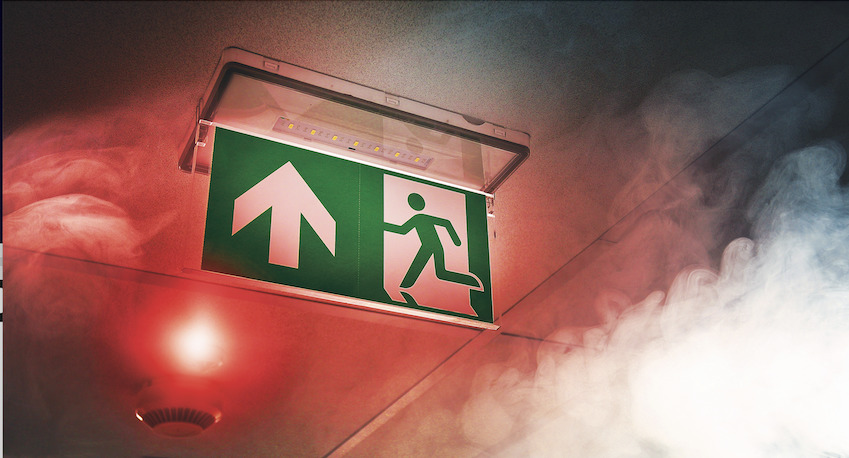
Louise Frost, a senior marketer at Door Controls Direct, explores the factors that influence accountability for passive fire protection in the built environment.
In the complex world of construction and building safety, few issues are as critical as fire protection. When it comes to safeguarding lives and property, passive fire protection plays a pivotal role.
However, like any system, it is not foolproof. When it fails, the consequences can be devastating. In such instances, fingers are pointed and the battle for accountability commences. Stakeholders seek to determine who should bear the responsibility for the failure of passive fire protection measures.
This article delves into this contentious and often divisive issue, exploring the key players, the factors at play, and the challenges of assigning accountability when passive fire protection falls short.
The role of passive fire protection
Before we dive into the battle for accountability, it’s essential to address the question: what is passive fire protection? What exactly does it entail, and why is it so crucial in the first place?
Passive fire protection encompasses a wide range of architectural and structural elements designed to limit the spread of fire and smoke within the built environment. These include fire-resistant materials applied to structural beams, fire doorsets, cavity barriers, fire-stopping compounds, and more.
The primary objectives of passive fire protection are twofold: to protect occupants by providing them with a safe means of escape during a fire and to minimize property damage.
When passive fire protection is effective, it can buy valuable time for both occupants and the fire rescue services (FRS). It provides a facility’s users with time to safely evacuate and for the FRS to contain the blaze before it spirals out of control.
The stakes in play
When passive fire protection fails, the stakes couldn’t be higher. Lives are at risk, property is in jeopardy, and the aftermath can be catastrophic.
Let’s take a look at the key stakeholders in the battle for accountability:
- Building Owners: Building owners are often the first to be held accountable when passive fire protection fails. They are responsible for ensuring that their properties meet safety regulations and standards. Failure to do so can lead to fines and even imprisonment.
- Architects and Designers: Those who plan and design buildings play a critical role in determining the effectiveness of passive fire protection. If a building’s design inadequately addresses fire safety requirements, architects and designers may be held liable for any resulting failures.
- Contractors and Builders: Those responsible for the physical construction of a building must ensure that the materials and techniques used for passive fire protection adhere to standards and regulations.
- Regulatory Authorities: Government agencies responsible for setting and enforcing building codes and fire safety regulations also play a role in accountability. If regulations are unclear or insufficient, or if they are not rigorously enforced, the effectiveness of PFP measures will continue to be compromised.
- Manufacturers of Fire Protection Products: Companies that produce passive fire protection products must ensure that their products meet stringent safety standards. If their products are found to be defective or substandard, they may be held liable for any failures.
- Occupants and Users: In some cases, occupants and users of a building may also be accountable if their actions or negligence contribute to a fire or hinder evacuation efforts.
- Employers: The Regulatory Reform (Fire Safety) Order 2005 section 3 includes employers under the banner of ‘responsible person’ “if the workplace is to any extent under his control”.
The complex factors
Several complex factors contribute to the challenges of assigning responsibility when passive fire protection fails:
- Regulatory ambiguity
Building codes and regulations can vary significantly by region and certainly of late, have been subject to frequent updates and revisions. This can lead to ambiguity in compliance requirements and challenges in determining whether a building adheres to the applicable regulations.
- Human error
Errors can occur at various stages of the construction process, from design to construction. With people involved at every stage, no matter how automated some processes are, it’s inevitable. Identifying which party is responsible for a specific error can be challenging, as it often involves multiple stakeholders.
- Aging infrastructure
As buildings age, passive fire protection systems can deteriorate and become ineffective. Determining whether the responsibility lies with the original builders, subsequent maintenance contractors, or the current owner can be complex.
In more cases than we’d like to believe, cost considerations lead to compromises in passive fire protection measures. Deciphering whether cost-cutting decisions were made knowingly or unknowingly is a point of contention.

Oversight as out of sight
Passive fire protection can be easily overlooked during the construction process. Out of sight so out of mind, or at least something that is deprioritised for some amoral individuals. A lack of regular inspections and maintenance also contributes to PFP failures.
Legal battles and precedents
The battle for accountability often plays out in the legal arena, with lawsuits and court decisions shaping the landscape of responsibility. Legal cases involving passive fire protection failures set important precedents, influencing how responsibility is assigned in future cases.
- Cost-Driven Decision-Making
One notable example is the case of the MGM Grand Hotel and Casino fire in 1980 in Las Vegas. The fire, which claimed 85 lives and injured hundreds, was caused by an electrical fault and fuelled by flammable interior finishes.
The subsequent investigation revealed shortcomings in passive fire protection. The legal battle that followed involved multiple parties, the outcome of which was a significant settlement that held various parties accountable.
Decades later in the UK, we were faced with the Grenfell Tower fire in 2017. 72 fatalities due to the rapid spread of fire, which was attributed to the building’s highly flammable cladding.
This case highlighted the complexities of assigning accountability, involving not only the building’s owner but also the manufacturers of the cladding, the contractors, and the regulatory authorities responsible for the life-ending oversight.
To take a cynical view, there is money in PFP measures, with an estimated market value of $31 billion by 2026. So, for that reason alone, why aren’t more individuals or companies pressing for more action to be taken?
Preventing failures and promoting accountability
While assigning accountability after an incident is important, preventing passive fire protection failures in the first place is the primary goal. Here are some steps to consider in order to promote accountability and enhance fire safety:
- Stringent regulations: Governments and regulatory bodies must ensure that building codes and fire safety regulations are clear, regularly updated, and rigorously enforced. This includes regular inspections and compliance checks.
- Education and training: Architects, designers, contractors, and manufacturers should receive comprehensive training on fire safety and passive fire protection. This education should emphasize the critical role they all play in ensuring building safety.
- Maintenance and inspections: Building owners should prioritize regular maintenance and inspections of all fire protection systems, active and passive, to ensure they remain in good working condition.
- Ethical decision-making: Stakeholders should prioritize safety over cost-cutting measures. Ethical decisions need to be made that prioritize the well-being of occupants and property, sourcing products that meet all of the required standards, from a dependable supplier, and having them installed by qualified trades.
- Industry collaboration: Architects, contractors, manufacturers, and regulatory authorities should collaborate to create industry best practices that promote effective passive fire protection.
Moving forward together
The battle for accountability when passive fire protection fails is a complex and contentious issue that involves multiple stakeholders and factors. While legal battles may provide a resolution in individual cases, the broader goal should be to prevent failures from occurring in the first place.
By implementing stringent regulations, promoting education and training, and prioritizing ethical decision-making, we can enhance passive fire protection and, ultimately, save lives and protect property. The battle for accountability should serve as a reminder.








